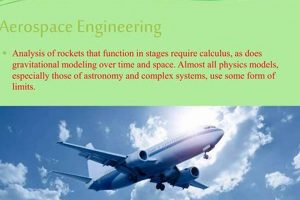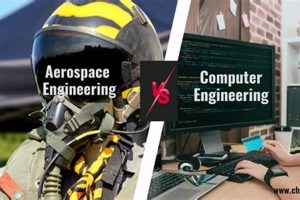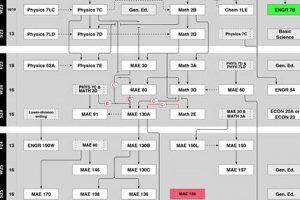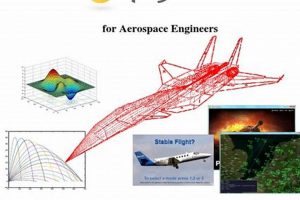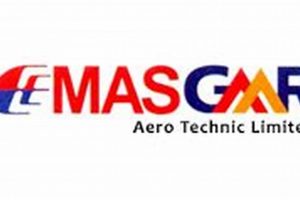The Jonsson School of Engineering and Computer Science at The University of Texas at Dallas offers a specialized program focused on the design, development, and testing of aircraft and spacecraft. This curriculum equips students with a strong foundation in aerodynamics, propulsion, structures, and control systems. Students learn to apply scientific and mathematical principles to solve complex challenges in the aerospace sector.
This specialized educational path holds considerable importance due to the growing demand for skilled professionals in the aerospace industry. Graduates contribute to advancements in air travel, space exploration, and national defense. The historical development of this field reflects the continuous pursuit of innovation in flight and related technologies, shaping modern society through breakthroughs in materials science, avionics, and satellite communication.
The following sections will delve into specific aspects of the program, including curriculum details, research opportunities, faculty expertise, and potential career paths available to graduates. Further discussion will highlight the resources and facilities that support the program, and how the program contributes to the broader aerospace community.
Tips for Success in Pursuing a Degree in Aerospace Engineering at UT Dallas
The following tips are intended to provide guidance for students interested in pursuing a degree in aerospace engineering at The University of Texas at Dallas. These suggestions address key areas for academic success and professional development within the field.
Tip 1: Cultivate a Strong Foundation in Mathematics and Physics. A solid understanding of calculus, differential equations, linear algebra, and fundamental physics principles is essential for mastering core aerospace engineering concepts. Students should prioritize these subjects in their early coursework.
Tip 2: Engage Actively in Hands-On Projects. Participating in design, build, and test projects provides invaluable practical experience. Consider joining student organizations such as the Rocketry Team or the Unmanned Aerial Vehicle (UAV) club to gain real-world skills.
Tip 3: Seek Research Opportunities with Faculty. Working alongside professors on research projects offers exposure to cutting-edge advancements and allows students to contribute to knowledge creation. Approach faculty members whose research interests align with personal career goals.
Tip 4: Develop Proficiency in Computer-Aided Design (CAD) Software. Familiarity with industry-standard CAD software such as SolidWorks, AutoCAD, or CATIA is crucial for design and analysis tasks. Utilize available tutorials and workshops to build competence in these tools.
Tip 5: Attend Industry Events and Networking Opportunities. Participating in conferences, seminars, and career fairs allows students to connect with industry professionals and learn about current trends and job opportunities. Networking can lead to internships and full-time employment after graduation.
Tip 6: Prioritize Effective Communication Skills. Aerospace engineers must be able to communicate technical information clearly and concisely, both orally and in writing. Practice presenting research findings, writing technical reports, and collaborating with team members.
Tip 7: Maintain a Strong Academic Record. A high GPA is often a prerequisite for internships, research positions, and graduate school admissions. Dedication to academic excellence is essential for maximizing future opportunities.
Adhering to these guidelines will equip students with the knowledge, skills, and connections necessary to excel in this demanding and rewarding field. A proactive approach to learning and professional development is key to achieving success.
These tips provide a foundation for aspiring aerospace engineers at UT Dallas. Further exploration of specific program resources and faculty guidance will enhance the student experience and prepare graduates for successful careers.
1. Curriculum Rigor
Curriculum rigor within aerospace engineering programs directly influences the competence of graduates entering the workforce. A demanding curriculum compels students to engage deeply with fundamental principles, advanced theories, and practical applications. This intensive study results in a more robust understanding of aerospace systems, preparing individuals to address complex engineering challenges.
At UTD, the aerospace engineering curriculum incorporates challenging coursework in areas such as aerodynamics, propulsion, structures, and control systems. The curriculum often uses real-world case studies, design projects, and simulations to test theoretical knowledge. For instance, students may be tasked with designing a composite wing structure to meet specific aerodynamic and structural requirements, thereby integrating multiple engineering disciplines. Furthermore, stringent evaluation methods ensure students master the material.
Ultimately, curriculum rigor is a crucial component of a successful aerospace engineering program. A challenging academic experience prepares students to innovate, problem-solve, and contribute to the advancement of aerospace technology. However, maintaining curriculum rigor also presents a challenge, requiring continuous updates to reflect technological advancements and evolving industry demands, ensuring program relevance and effectiveness.
2. Faculty Expertise
The faculty within The University of Texas at Dallas’s aerospace engineering program constitute a vital component, directly influencing the quality of education and research output. Their expertise, encompassing both theoretical knowledge and practical experience, shapes the curriculum, research direction, and overall learning environment. For example, a professor specializing in computational fluid dynamics (CFD) might lead research projects aimed at optimizing aircraft wing designs, providing students with hands-on experience in applying advanced simulation techniques.
A direct correlation exists between faculty expertise and the program’s ability to attract research funding, publish impactful research papers, and foster collaborations with industry partners. Faculty members with established reputations in specific aerospace sub-disciplines enhance the program’s visibility and credibility. This, in turn, attracts high-caliber students and increases opportunities for internships and post-graduation employment. Furthermore, faculty often serve as mentors, guiding students in their academic pursuits and career development. This mentorship is invaluable, providing students with insights into the profession and helping them navigate the complexities of the aerospace industry.
In summary, faculty expertise is fundamental to the success of an aerospace engineering program. Their knowledge, research activities, and mentorship contribute significantly to the program’s academic rigor, research productivity, and the career readiness of its graduates. Attracting and retaining highly qualified faculty remains a key priority for UTD, ensuring the program continues to produce future leaders in the aerospace field. The challenge lies in continuously supporting faculty development and providing resources to foster their research endeavors.
3. Research Opportunities
Research opportunities form a cornerstone of the aerospace engineering program at The University of Texas at Dallas, providing students with practical experience and exposure to cutting-edge advancements in the field. These experiences are integral to developing well-rounded engineers capable of addressing complex challenges in the aerospace sector.
- Faculty-Led Research Projects
Faculty-led research projects are a primary avenue for student involvement. Professors with expertise in areas such as aerodynamics, propulsion, and materials science conduct research on diverse topics, including hypersonic flight, advanced composite materials, and satellite systems. Students participating in these projects gain hands-on experience in experimental design, data analysis, and scientific writing. For example, a student might contribute to a project focused on developing a new type of heat shield for spacecraft re-entry, gaining valuable insights into thermal protection systems.
- Undergraduate Research Programs
UTD offers dedicated undergraduate research programs that provide funding and mentorship to students pursuing independent research projects. These programs allow students to explore their specific interests within aerospace engineering, fostering innovation and critical thinking. A student might design and build a small-scale wind tunnel to study the aerodynamic characteristics of different airfoil designs, culminating in a research presentation or publication.
- Industry Collaborations
The aerospace engineering program maintains strong connections with industry partners, facilitating research collaborations between students, faculty, and companies in the aerospace sector. These collaborations provide students with opportunities to work on real-world engineering problems, gaining valuable experience in a professional environment. For instance, a student might participate in a joint project with a local aerospace company to develop a new flight control system for unmanned aerial vehicles (UAVs).
- Research Facilities and Equipment
Access to advanced research facilities and equipment is essential for conducting cutting-edge aerospace research. UTD provides students with access to state-of-the-art laboratories, wind tunnels, computational resources, and materials testing equipment. These resources enable students to conduct sophisticated experiments and simulations, furthering their understanding of aerospace principles. The ability to utilize these resources allows students to contribute meaningfully to ongoing research efforts.
These research opportunities at UTD not only enhance students’ technical skills but also cultivate their problem-solving abilities and critical thinking. Through participation in these initiatives, students are better prepared to tackle the challenges of the aerospace industry and contribute to its continued advancement.
4. Industry Connections
Strong ties to the aerospace industry form a vital component of a successful aerospace engineering program, impacting curriculum relevance, research opportunities, and graduate employment prospects. These connections provide students and faculty with access to real-world engineering problems, internship positions, and potential career paths. The relationship between UTD’s aerospace engineering program and the industry fosters a symbiotic exchange of knowledge and resources, benefiting both parties. For example, partnerships with companies like Lockheed Martin or Boeing can provide UTD students with access to cutting-edge technologies and engineering practices, informing curriculum design and research directions.
Further, direct engagement with industry allows for the identification of skill gaps in graduates, enabling the program to adapt its curriculum to meet evolving industry needs. Guest lectures from industry professionals, site visits to aerospace facilities, and collaborative research projects enhance students’ understanding of practical engineering applications. A consequence of robust industry collaboration is the increased likelihood of securing funding for research initiatives, furthering technological innovation within the department and providing students with valuable research experience. Another example is the collaboration with NASA, that provides invaluable research opportunities that otherwise wouldn’t exist.
In summary, industry connections are integral to the success and relevance of aerospace engineering programs. They provide opportunities for practical learning, curriculum enhancement, and career development, leading to a more prepared and competitive workforce. Maintaining and strengthening these connections is a continuous endeavor, requiring proactive engagement with industry partners and a commitment to aligning program goals with industry needs. The long-term impact of strong industry relationships is a sustainable pipeline of qualified aerospace engineers prepared to address the challenges and opportunities of the aerospace sector.
5. Facilities Quality
The quality of facilities directly impacts the effectiveness of the aerospace engineering program at The University of Texas at Dallas. Well-equipped laboratories, advanced computational resources, and specialized testing equipment enable students and faculty to conduct cutting-edge research and develop practical skills essential for success in the aerospace industry. For example, access to a modern wind tunnel allows students to validate aerodynamic theories and optimize aircraft designs, while advanced materials testing equipment facilitates research on novel composite materials for aerospace applications. The availability of such facilities directly influences the scope and quality of research conducted, and the development of skills necessary for graduates to make significant contributions to the field.
Further, the quality of facilities often dictates the program’s ability to attract and retain both talented faculty and high-achieving students. State-of-the-art laboratories and research centers provide a stimulating environment for innovation and discovery. Conversely, outdated or poorly maintained facilities can hinder research progress and limit the educational experience. Examples of beneficial facilities include advanced computational clusters for simulating complex aerodynamic flows, dedicated spaces for building and testing unmanned aerial vehicles, and specialized laboratories for propulsion system research. The availability of these resources enables students to participate in hands-on projects and contribute to groundbreaking research, enhancing their competitiveness in the job market.
In summary, facilities quality constitutes a critical factor in the success of the aerospace engineering program at UTD. Investment in modern facilities is essential for fostering innovation, attracting top talent, and preparing graduates for the challenges of the aerospace industry. Challenges may arise from the high costs associated with maintaining and upgrading specialized equipment, requiring strategic planning and resource allocation to ensure the program remains at the forefront of aerospace engineering education and research. By prioritizing facilities quality, UTD can effectively strengthen its aerospace engineering program, contributing to advancements in flight, space exploration, and related technologies.
Frequently Asked Questions about UTD Aerospace Engineering
This section addresses common inquiries regarding the aerospace engineering program at The University of Texas at Dallas, providing concise and factual answers.
Question 1: What distinguishes the aerospace engineering program at UTD from other similar programs?
The UTD program distinguishes itself through its emphasis on hands-on experience, strong industry connections, and research opportunities, facilitated by state-of-the-art facilities and faculty expertise in specialized areas such as hypersonics and advanced materials.
Question 2: What are the typical career paths for graduates of the UTD aerospace engineering program?
Graduates pursue careers in various sectors, including aerospace manufacturing, research and development, government agencies, and consulting firms, often working as design engineers, systems engineers, or project managers.
Question 3: What are the admission requirements for the UTD aerospace engineering program?
Admission requirements include a strong academic record in mathematics and science, standardized test scores (SAT/ACT), and a compelling personal essay. Specific GPA and test score thresholds are detailed on the university’s admissions website.
Question 4: Are there opportunities for undergraduate research within the UTD aerospace engineering program?
Yes, numerous opportunities exist for undergraduate research, including participation in faculty-led projects, independent research initiatives, and collaborative research with industry partners, fostering practical skills and innovation.
Question 5: Does the UTD aerospace engineering program offer any specialized tracks or concentrations?
While a formal concentration system may not be in place, students can tailor their coursework and research to focus on specific areas of interest, such as aerodynamics, propulsion, or structural mechanics, under the guidance of faculty advisors.
Question 6: What resources are available to support students in the UTD aerospace engineering program?
Resources include access to state-of-the-art laboratories, computational facilities, tutoring services, career counseling, and student organizations, designed to promote academic success and professional development.
The UTD aerospace engineering program is designed to provide a rigorous and comprehensive education, preparing graduates for successful careers in the aerospace industry.
The following section provides details regarding resources for current and prospective students.
UTD Aerospace Engineering
This exploration of UTD Aerospace Engineering has illuminated key facets of the program, encompassing curriculum rigor, faculty expertise, research opportunities, industry connections, and facility quality. Each element contributes to the program’s comprehensive approach to educating future aerospace professionals. The program’s success is dependent on the synergistic interplay of these elements.
The significance of UTD Aerospace Engineering extends beyond academic training, shaping the future of aerospace innovation and contributing to national competitiveness. Further inquiry into specific program initiatives and student outcomes is encouraged to fully appreciate the program’s impact and potential.


